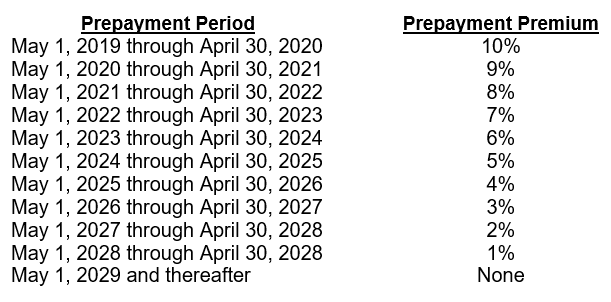The FHA / HUD 232/223(a)7 loan program provides an expedited refinance option for existing FHA-insured loans in order to reduce a project's debt service burden by lowering the interest rate and extending the maturity date. Qualifying projects stand to continue benefiting from the credit enhancement afforded by the FHA / HUD loan insurance program with the same attractive features of the existing FHA-insured loan but with lower debt service payments. Key characteristics of this 232/223(a)7 loan program include:
The following is a detailed discussion on the 232/223(a)7 loan program. A summary term sheet can be accessed here: 232/223(a)7 Term Sheet.

Eligible properties under the 232/223(a)7 loan program include skilled nursing, assisted living, and board & care facilities with existing FHA-insured loans.
The Owner/Mortgagor entity can be for-profit, non-profit, private, or public, but must be a single asset entity whose sole asset represents the project under financing consideration. Natural person and tenancy in common (TIC) ownership structures are generally not permitted.
FHA / HUD insured loans are generally non-recourse. No individual assumes personal liability for payments due under the loan documents. However, key principals can be personally liable for certain bad acts set forth in the loan documents, including misallocating insurance proceeds, improper maintenance of books and records, authorizing the conveyance, assignment, transfer, pledge, encumbrance, or other disposition of the mortgaged property without prior approval from HUD, and for other intentional bad acts defined in the loan documents.
The FHA / HUD 232/223(a)7 loan has a term up to 12 years beyond the maturity of the existing loan being refinanced, not to exceed the loan term of the original FHA-insured loan first insured by HUD.
|
Year
|
Average
|
|
2018
|
3.19%
|
|
2019
|
NA
|
|
2020
|
2.82%
|
|
2021
|
2.67%
|
|
2022
|
3.63%
|
|
AVERAGE
|
2.93%
|
Between 2018 and 2022, average interest rates on 232/223(a)7 loans ranged from approximately 2.65% to 3.65%, according to HUD published data. You can visit here for more current indications.
The loan sizing parameters for FHA / HUD 232-223(a)7 loans are generally the lower of the:
Lockout and prepayment penalties are negotiable, but best interest rate pricing is typically secured with a 10-year call protection (a lockout period and/or prepayment penalties over the 10 years following closing).

Sample prepayment penalty language from a Note of a HUD insured loan.
A common prepayment penalty structure is the “10-9-8-7-6-5-4-3-2-1-0” structure where the prepayment penalty is 10% in year 1, followed by a 1% reduction upon each 1-year anniversary so that the prepayment penalty is 0% upon the 10-year anniversary. Shorter call protection may increase the interest rate the FHA Lender is able to offer. For example, borrowers have been quoted a 50-60 basis point interest rate premium for a shorter 5-year call protection.
232/223(a)7 loans are fully assumable, subject to Lender & HUD approval and fees. HUD typically imposes a 0.50% TPA (Transfer of Physical Asset) fee for transactions involving transfers of control of more than 50% ownership interest. Lender fees may vary but are typically commensurate with incurred legal and administrative fees.
Typically, 0.5% – 1.0%. Lender financing fees are determined based on market conditions and the size and complexity of the proposed transaction, subject to HUD limitations. Current HUD regulations permit maximum lender fees on 232/223(a)7 loans up to 2.0% of the loan amount, except on transactions involving bond financing where such fees are permitted up to 4.0%.
HUD imposes an application fee of 0.15% of the loan amount to review the application to determine whether the proposed loan qualifies for HUD mortgage insurance. The HUD application fee is due to HUD at application submission. The application fee paid to HUD at application submission equals 0.15% of the loan amount applied for. The final application fee owed to HUD is based on the final loan amount at closing. Any difference between the fee(s) paid at application submission and the fee owed based on the final loan amount is due at closing.
Not Applicable. HUD does not impose an inspection fee under this loan program, even if repairs are required.
0.50% for first year due upfront at closing
0.45% annually thereafter for healthcare facilities with LIHTC
0.55% annually thereafter for healthcare facilities without LIHTC

The HUD mortgage insurance premium fee (HUD MIP) is a fee charged by HUD for providing a credit enhancement in the form of FHA mortgage insurance which provides access to the advantageous interest rate terms available under the HUD loan program. Presently, the initial and annual MIP rates imposed by HUD are 0.50% (initial) & 0.45% (annual) for qualifying healthcare facilities that are financed with Low Income Housing Tax Credits (LIHTC) and 0.50% (initial) and 0.55% (annual) for qualifying healthcare facilities that are financed without LIHTC.
The most recent notice regarding HUD healthcare facility MIP rates is available here: Current Mortgage Insurance Premiums (MIP).
Project Capital Needs Assessment (PCNA), Phase I Environmental Site Assessment (Phase I ESA), and radon testing may be required under certain conditions. A PCNA is typically required if the refinance involves a term extension beyond the maturity date of the existing loan or if it has been more than 10 years since a prior PCNA was completed. A Phase I ESA and radon testing are generally required if the levels of proposed or required repairs is considered rehabilitation activities versus maintenance activities, which is further defined by HUD in this published notice.
The PCNA provides an assessment of the property and site condition and identifies required immediate and future capital repairs and replacements. The PCNA’s conclusions help determine any required repairs and repair escrow (if completed post-closing), the required initial deposit to replacement reserves due at closing, and the required monthly deposit to replacement reserves thereafter. The Phase I ESA determines whether any environmental conditions exist at the project that represent a risk which would require further action. Radon testing evaluate the existence of elevated radon levels (above 4.0 pCi/L) that would need to be mitigated. HUD's radon testing requirements are now applicable to all projects regardless of their EPA radon zone.
TAX & INSURANCE. HUD requires that the FHA Lender collect and maintain tax and insurance escrows in order to ensure that: (a) there are sufficient funds available to pay real estate taxes; and (b) there are sufficient funds available to pay insurance premiums for insurance coverages as required by the HUD Loan Program. The construction loan budget typically allocates funds to cover anticipated taxes and insurance during construction. After the construction period of the loan and upon commencement of loan amortization, the Lender typically bills for and collects funds to cover tax and insurance expenses along with each monthly principal and interest payment. The tax and insurance amounts collected each month is based upon the amount necessary to pay all insurance premiums, real estate taxes, and governmental assessments at least thirty days prior to each due date for each year during the term loan.
REPLACEMENT RESERVES. HUD requires that the FHA Lender collect and maintain capital replacement reserves to ensure that there are sufficient funds available to fund capital replacement needs as they come due. Replacement reserves are typically held in escrow by the Lender in an interest-bearing account with an acceptable financial institution. At closing, the Lender is required to collect an initial deposit to capital replacement reserves and then bills for and collects funds for monthly capital replacement reserve deposits. The minimum HUD required initial and annual deposit is set at a level that ensures a minimum balance of $1,000 per unit in years 1 through 15 based on the anticipated levels of funding required to meet anticipated capital replacement needs based on the Capital Needs Assessment completed during application processing.
REPAIRS. At closing, HUD requires that the Lender collect and maintain an escrow for 100% of the estimated cost to complete required repairs identified in the CNA that are not completed prior to closing, plus a 20% contingency in case of cost overruns. The repair escrow is released upon completion of required repairs, except for a 2.5% repair estimate holdback for potential latent defects when the repair budget exceeds $1,000,000. When applicable, the latent defect holdback may be released 15 months following completion of repair work assuming such repair work is in good order.
The required escrow amount is determined by the Lender and HUD during application processing, based on HUD’s Initial Operating Deficit Calculation Template which analyzes the projected deficit from operating expenses and monthly debt service payments that are anticipated to exceed income collections during the lease-up period. Other risk factors associated with the project may further increase the operating deficit escrow requirement.
DEBT SERVICE RESERVES. For projects with unusual long-term risk, HUD may require a long-term debt service reserve for the life of the loan, the requirement and amount of which will be determined by HUD during its application review.
HUD 232/223(a)7 loan program requirements do not impose any Davis-Bacon prevailing wage requirements.
Typically, 3-5 months from engagement to closing. Timeframes may vary significantly, depending on the complexity of the transaction, borrower cooperation, and the volume of loan applications being processed by HUD. To better appreciate the timing considerations, it is important to understand the FHA / HUD 232/223(a)7 loan application process.
HUD APPLICATION. Given the level of due diligence completed with the original HUD financing, the 232/223(a)7 loan application is less involved. Typically, there is no appraisal requirement and there are fewer required exhibits. Still, the 232/223(a)7 loan application may require a PCNA, Phase I ESA, and radon testing (see Third Party Reports), plus some credit and due diligence items on the project and its key principals. The Lender’s loan underwriting synthesizes all the data and analysis into a HUD commitment application for mortgage insurance. The Lender’s application preparation and submission generally takes between 1-2 weeks from the time all requisite items are provided. Once an application has cleared the ORCF 232 Underwriting Queue and is assigned an underwriter, HUD’s review typically takes up to 30 days, sometimes longer.
CLOSING. Once HUD has completed its review and is satisfied with the application, HUD will issue its approval in the form of a HUD Commitment for mortgage insurance along with its terms and conditions to close. If acceptable to the parties, the attorneys will be engaged to prepare and review the loan documents and required due diligence. Lender’s counsel will assemble a pre-closing package and, upon completion, submit to HUD. HUD will then review the pre-closing submission and, if acceptable, clear the project to close. This process generally takes between 30-60 days.
We hope you find this information helpful. If you are interested in seeing what an FHA / HUD 232/22(a)7) loan can do for your project, you can Apply Here. If you have further questions or would simply like to speak with an expert in the field, feel free to Contact Us.
© ADROC CAPITAL LLC. ALL RIGHTS RESERVED. | Privacy Policy